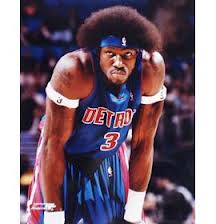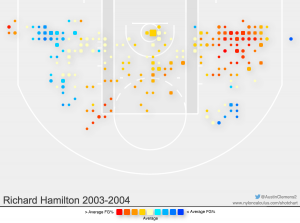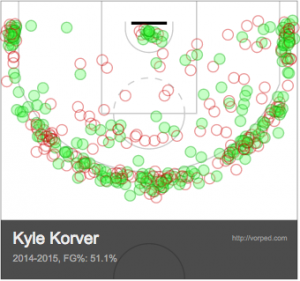
 If you were to browse through the list of NBA champions since 1980, you’d find that there is just one notable outlier to the rule that suggests title contenders need a superstar to win it all — the 2003-04 Pistons.
If you were to browse through the list of NBA champions since 1980, you’d find that there is just one notable outlier to the rule that suggests title contenders need a superstar to win it all — the 2003-04 Pistons.
While that Detroit team featured four players who were either already multi-time All-Stars or went on to become multi-time All-Stars later in their careers, no one would have mistaken any of those Pistons players as the prototypical “superstars” entering the 2004 postseason.
While the Pistons were clearly one of the league’s better teams throughout the 2003-04 regular season, their eventual demolition of the Lakers in the Finals opened eyes around the league and became one of the NBA’s most surprising championship upsets in recent memory.
Eleven seasons later, the 2014-15 Atlanta Hawks enter All-Star Weekend with championship aspirations and a distinct lead for home-court advantage in the Eastern Conference. Still, fans and analysts are asking the same question that surrounded Detroit: “Can this team win it all without a superstar?”
As coincidence would have it, one of the role players from that Detroit championship roster is now serving on Mike Budenholzer’s coaching staff in Atlanta. Prior to a recent marquee matchup against a Western Conference contender, Hawks Assistant Coach Darvin Ham took the time to compare these Hawks with those championship Pistons.
Jacob Eisenberg: “When you first signed with the Pistons in September of 2003, they hadn’t won a championship yet. There seemed to be that same cloud of doubt about whether they could win without a superstar or without that “go-to guy.” Chauncey Billups only became “Mr. Big-Shot” after he had opportunities to make big shots in the playoffs. What was the feel around that team and how does it compare to the feel over here?”
Darvin Ham: “It was similar in the fact that we all stayed in our own bubble. We focused on us and we focused on how we could get better every day. It was a hard working team. It’s funny because out of the active roster, I want to say that we had 13 people on the roster but I think 11 of us had been starters somewhere else before in our careers.
It’s very similar to what we are right now as the Atlanta Hawks in the fact that we might not have that elite superstar caliber player but we have a lot of very, very good players. In my opinion, they’re elite just due to the fact that they’re willing to share. They share the responsibility and they share in the glory. They share in the responsibility of making sacrificial plays that make each other look well and advance us to victory as a team. It’s the same formula. Little parts are a little bit different; but the way we handle our business and the way the guys are on and off the floor in terms of camaraderie is very much identical. Very much identical.”
JE: “If we compare position-by-position with what the players can do, Chauncey and Jeff Teague have a lot of overlap.”
DH: “Absolutely.
Chauncey was always steady with the ball, just as Jeff is. They kind of balance each other out when you compare them because I don’t think Jeff is quite the shooter Chauncey was, but Chauncey damn sure wasn’t the driver that Jeff is! And tell Chauncey I said that! (laughs) Chauncey’s my brother, I love him. It’s the same steadiness between them, manning the team and being the general on the floor.”
JE: “Where do Kyle and Richard (Rip) Hamilton’s roles for their teams overlap in terms of moving non-stop without the ball?”
DH: “They just run the other team into the ground, man! They’re just parts that fit. Kyle and Rip are very, very identical. But Rip was more of a pin-down guy from 15-21 feet from the hoop, just curling and getting open looks that way. He was always running the defender into the ground. Kyle is the same way. But Kyle is actually a little bigger and longer and more physical as far as going in there and getting tough rebounds and things like that. But those two are right on par with each other.”
JE: “When you think of Tayshaun Prince and DeMarre Carrol, what comes to mind?”
DH: “With Tayshaun and DeMarre, again there are a lot of similarities. They are almost the unsung heroes of the unit. The hustle guys. Basically the glue guys that makes it all work. They can do a little bit of everything. DeMarre can score when you need him to, he can get a stop when you need him to, he can get a big rebound when you need him to. He just makes energy plays, diving on the floor and what not. Tayshaun was the same way. He’d guard whoever you put in front of him.”
JE: “The front court is interesting because while there is a similar talent overlap, the roles that the players perform are vastly different.”
DH: “Of course Al and Paul are way different than Ben and ‘Sheed. But the way they play off of each other and the way they can switch up match-ups is similar. They can both switch on the smalls and do an above average job – a really good job – of keeping the guard in front of them if there’s a switch on the floor. The similarities are there.”
JE: “Let’s talk about the bench.”
DH: “Our bench here is just like our bench was there.
– Pero (Antic) knows his role on defense and can knock down the perimeter shot like Mehmet Okur did.
– I think about Mike Scott whose knack for scoring was just like Corliss Williamson’s.
– I didn’t shoot threes but Thabo is a lot like how I was in terms of taking on the defensive responsibility from the bench.
– With Mike James and Lindsay Hunter, we called them pit bulls. Then you look at Dennis and Kent Bazemore and the way they defend and it’s scary, man.
– Then we have the elder statesman. We’ve got Elton Brand and back then we had Elden Campbell.
It’s a really good comparison and I love it because if we’re being compared to a team like that, then we’re heading in the right direction.”
JE: “The first thing people are going to be quick to point out with this comparison is that Al doesn’t protect the rim like Ben Wallace did. They are similar in terms of how important they are for the defense but are very different in how they use their talents.”
DH: “Absolutely. I think Al has made leaps and bounds in getting back comfortable physically. After the two injuries to both his pecks, physically you see the confidence when he goes in and attacks the rim. And defensively, his verticality and blocking shots at the rim, I think it’s amazing.
You know, nobody is a Ben Wallace. You’re talking about a four-time Defensive Player of the Year. But still, people would play off of Ben on the other end and you can’t do that with Al. There’s always a segment in comparing these individuals where it’s a little more on this side for this guy but it’s a little more on that side for the other guy. It balances out in the end.”
JE: “Without a rim protector on this team, the biggest strategy on defense has been as simple as just getting back. You’ve sacrificed offensive rebounds to prioritize getting back on defense. How important is that strategy to compensate for the lack of rim protection?”
DH: “It’s huge. It’s your first line of defense. What would you rather have: say 8-to-12 extra possessions where you’re not guaranteed to score or really getting back and preventing them from getting maybe 12-to-20 fast break points?
To me, the defensive element of getting back and getting our activity and energy there is crucial. In my opinion, the rim protector thing is a little overrated. As long as you’re moving and doing your work early, we’re able to compensate.
We have a systematic defense where if a guy gets broken down from the perimeter, there’s going to be a guy out to help there. And when that guy knows he’s going to have help behind him, he can come early and get into a good position. A charge is just as good as a blocked shot. Or verticality and protecting the net is just as good as a blocked shot. When that guy comes to help, that guy knows there’s someone else getting back to take his man off the glass. And then that guy back knows there’s someone else in help position to support if we have to close out on a perimeter shot. Systematically, our guys have the utmost confidence. Coach Bud has done a great job hitting home and establishing our defensive system with practice and film. You look at the rim protector thing, some of these teams with these quote-unquote ‘rim protectors’ are the teams giving up the most points in the paint just because they’re relying on that one guy to stop whoever’s driving in there. We don’t want to be like that. We want to score like a team and defend like a team. If you look at it, it’s worked out pretty well up to this point.”
Interviewer’s Notes:
- In truth, fans probably remember the 2003-04 Billups more fondly than his statistics up to that point in his career had warranted. Billups was a bit of an undesired enigma early in his career. He had played for four teams through his first six seasons before finally latching on in Detroit in 2002 as a 26-year-old. Teague is 26 right now and has already submitted three seasons that statistically surpass any season Billups had before he turned 26. Billups’ reputation as a clutch X-Factor also took a while to develop: he didn’t win his first playoff series until 2003 — six years into his career. In the spring of 2004, when the Pistons started making their championship push, Billups was 27 years old and was averaging 16.9 points, 5.7 assists and 3.9 rebounds per game. Teague in 2014, at age 26, is averaging 17.0 points, 7.5 assists and 2.7 rebounds per game. For fans and media members to say Teague can’t be the Hawks’ go-to guy in the postseason is ignorant of fairly recent NBA history. Also, there’s this from last April: [youtube https://www.youtube.com/watch?v=Gj5hujHvKMU]
- In a similar vein to Billups, history tends to remember 2003-2004 Hamilton’s offensive prowess more favorably than how he performed at the time. For the entire 2003-2004 season, Hamilton attempted just 68 three-pointers — and made only 18 of them (.265%). In comparison to Korver this season, Hamilton accounted for 6.9 more field goal attempts per game and committed 1.2 more turnovers per game. While both players share similar reputations for being lethal at moving without the ball, Korver’s perimeter acumen leads to better floor spacing and efficiency on Atlanta’s behalf:


- Like Carroll in Atlanta, Prince was the only Piston in the starting five to never make an All-Star team. Still, in terms of earning respect from teammates and coaches, Carroll and Prince are both considered to be integral players. “Demarre is invaluable to our success,” Budenholzer noted prior to a recent game.
- Rasheed Wallace was ironically traded from Atlanta to Detroit at the trade deadline in 2004, just a week after Atlanta had acquired him from Portland. Wallace played in just 22 regular season games with Detroit before they ascended on their championship run. While Wallace was the Piston with the most accolades (two All-Star appearances early in his career) prior to the championship run, he averaged just 13.0 points and 7.8 rebounds in that first postseason with Detroit.
- In much the same way that Ben Wallace embodied the physicality and strength that the Pistons prided themselves on, Horford embodies the unselfishness and floor spacing that these Hawks rely on. For 2014-15, Horford already has scored more points than Wallace had for the entire 2003-04 season. Another major advantage that Horford owns in comparison is that his career 74% free throw conversion rate is an asset at the end of games, whereas Wallace’s 41% became a liability. The trade-off comes on the other end of the floor, where Wallace won four Defensive Player of the Year awards in five seasons. Wallace averaged 12.4 rebounds and 3.0 blocks per game in 2003-04 compared to Horford’s 7.3 rebounds and 1.3 blocks in 2014-15.
One final note: To be clear, while these two teams have similar levels of talent by position, they play drastically different styles on the court. Detroit allowed just 84.3 points per game (2nd of 29) and had approximately 87.9 possessions per game (24th of 29). These Hawks allow 96.8 points per game (4th of 30) and have 93.8 possessions per game (16th of 30). The NBA has changed greatly over the past decade. With more of an emphasis on tempo and efficiency, the game has extended to the perimeter. Want proof? Atlanta averages more three point attempts in first halves than Detroit averaged per game in 2003-2004.
Jacob Eisenberg is a college senior at Emory University and works as an NBA columnist for Sheridan Hoops, specializing in analytics-based scouting reports for individual players. Follow him on Twitter and check out his website.
Fantastic piece Jacob.
lnteresting comparison. l think you are overrating these ATL players individually though. The Pistons starting 5 had better players at every position across the board in my opinion.
But where comparisons to that team always fail is the defense. Any team that doesnt have a superstar and instead wins playing offense by commitee is always compared to that Pistons team, but that wasnt why that team won a championship, it was because they had an all time great defense.
So just taking a team with a bunch of 15 to 17 ppg scorers who play great together on offense but give up 97 ppg on defense isnt likely to yield the same results.
l get what Darvin says about the tradeoffs but l think Horford being better than Ben on offense, for example, doesnt make up the huge difference overall between these teams on defense.
The 83 ppg given up by the Pistons that year doesnt even tell how great they were on that end because about 50 of those games were before they got Rasheed. lf you look at the numbers with him that year, over those 49 games, 26 reg season/23 playoff games, they only gave up 79 ppg.
Thats how they won a title devoid of an offensive superstar. So unless ATLs defense can get to that level, its going to be tough to win it all just with balanced offense and a good D.
Also, the other major difference was Larry Brown was a Hall of Famer and a Budenholzer is just not on that level.
Not saying this to hate on ATL, but rather to point out not to overlook just how great that Pistons team was defensively, which is something not easily duplicated.
l think a more accurate comparison would be the 2006 Pistons under Saunders, who started 37-5 and had 4 all stars, similar to this ATL team. The 06 Pistons werent as good defensively as their past teams, but were better offensively and more balanced, but ultimately only got to the ECF for that same reason – because they werent as good defensively. Which is how l see ATL ending up. You have to be special at least 1 side of the ball to win the title imo. Just being really good at both usually doesnt get it done.